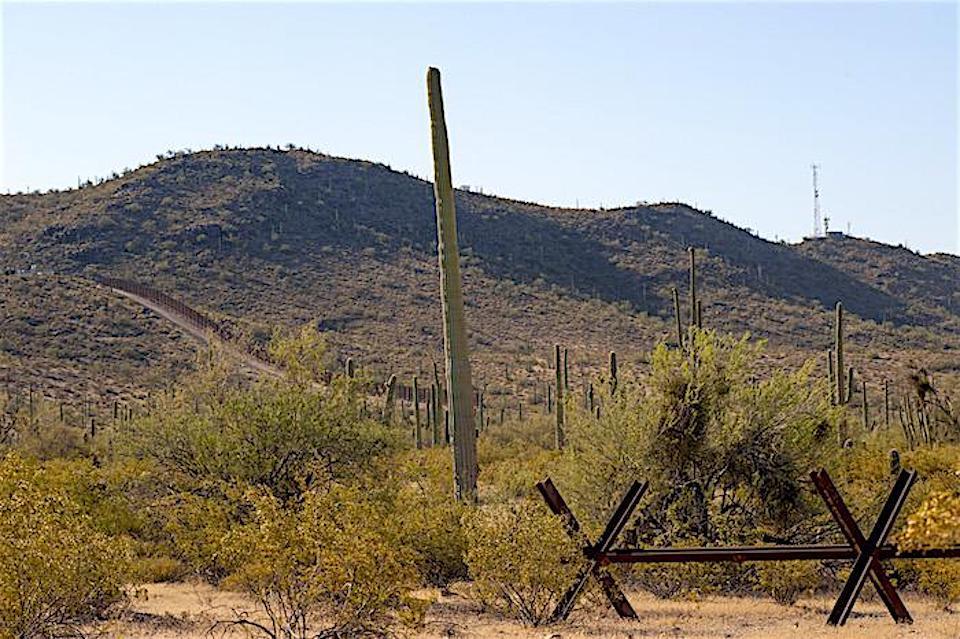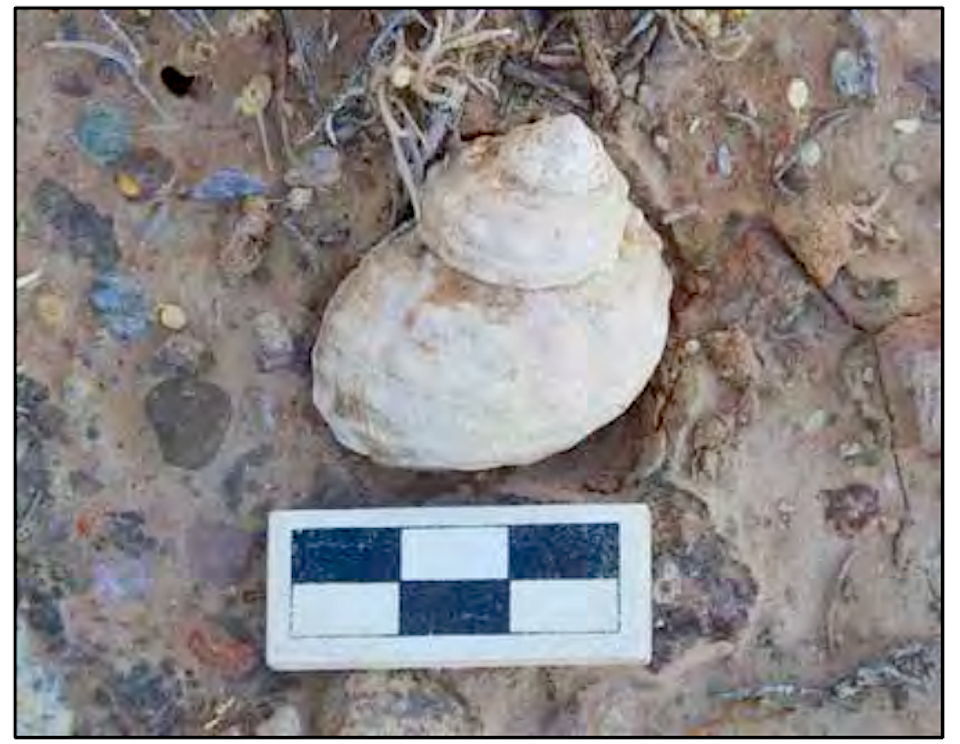
Archaeologists say border wall construction would destroy archaeological sites at Organ Pipe Cactus National Monument/Patrick Cone
Editor's note: This updates with response from National Park Service.
President Trump's determination to see a towering border wall built between the United States and Mexico very likely would destroy archaeological resources in Organ Pipe Cactus National Monument, a National Park Service report says.
A quick field survey along 11 miles of the national monument in Arizona near where the wall is proposed to be built identified five archaeological sites, and left the archaeologists of the mind that "significant, presently-unrecorded surface-level and buried archaeological deposits persist across the project (are), and we must assume that all such unrecorded deposits will be destroyed over the course of ensuing border wall construction."
The survey was done between June 24 and June 28 along the monument's southern boundary. That quick reconnaissance identified five sites, two that the Park Service archaeologists believe qualify for National Register of Historic Places listing.
Construction got under way in Organ Pipe earlier this summer. To facilitate that, the Park Service closed a road in the monument that runs east from the Lukeville, Arizona, port of entry almost all the way to the monument's eastern boundary.
Dr. Andrew Veech, who works for the Park Service's Intermountain Region Archaeology Program, couldn't talk about his field work Tuesday, saying he had been told not to speak to reporters.
In Washington, D.C., the agency's chief spokesman, Jeremy Barnum said that, "Due to their geographic orientation along the United States/Mexico border, a handful of parks are challenged with managing impacts stemming from various cross-border illegal activities. As such, the National Park Service works closely with the Department of Homeland Security to provide for life and safety and to protect monument resources. The National Park Service appreciates the role of an integrated Border Security approach and values the ongoing interagency efforts to address the multidimensional issue."
Earlier this year, the U.S. Customs and Border Protection announced its desire to build a tall barrier wall along the monument's 63-mile-long boundary with Mexico. While a federal judge in California initially blocked the plan to build a wall with concrete-filled steel bollards that would be approximately 6 inches in diameter, the U.S. Supreme Court overturned that ruling and cleared the way for construction to commence.
"The project entails the wholesale replacement of all existing vehicle barriers and pedestrian fencing along (Organ Pipe's) southern boundary with a new, continuous 9.1 m- (30-foot-) tall, steel bollard fence, undergirded by a 2.44 to 3.04 m- (8 to 10 foot-) deep concrete and steel foundation," noted the archaeological report, which the Washington Post obtained through a Freedom of Information Act request. "Likewise, the project includes the construction, expansion, and/or improvement of existing roads along the U.S. side of the border and the installation of spotlights and surveillance equipment."
Veech noted in the report that the Park Service had been told that once the construction began, the work would occupy a 60-foot wide swath of what's known as the "Roosevelt Reservation" in the monument. All told, the work could affect 218 acres within Organ Pipe, the report said.
"...the NPS regards the entire 18.3 m- (60-foot-) wide Roosevelt Reservation as an area of great concern, whose cultural and natural resources are imperiled."
In light of that prospect, he recommended that "all presently unsurveyed (or under-surveyed) sections of (Organ Pipe's) southern boundary be completed as soon as is possible, in light of impending border fence construction along the park’s entire 48.3 km- (30 mi-) long southern boundary, entailing ground disturbance across the whole, 18.3 m- (60 ft-) wide Roosevelt Reservation."

A mollusk shell found by archaeologists pointed to an ancient trade route/NPS, Andrew Veech
The Sonoran Desert cradled by Organ Pipe Cactus is unlike most other deserts in the world. It receives more rainfall, on average, than other deserts, and is biologically rich, with more than 600 plant species and more than 50 mammalian species. Nearly 300 bird species, and 50 types of amphibian and reptilian species, also have been counted in the monument. Taken as a whole, it’s understandable why the park in 1976 was designated an International Biosphere Reserve.
There’s rich human history here, too, dating back 15,000 years. The Old Salt Trail was used by cultures down through the centuries to bring salt, seashells, and obsidian gathered from Sea of Cortez salt beds at Sonora, Mexico, northward through this landscape. The Tohono O’odham culture relied on the fruit of the saguaros and organ pipe cactus for food.
More recent history is seen in the clutter of abandoned mines that prospectors had hoped would make them rich in gold and copper. Early ranchers also impacted the landscape, as cattle overgrazed many areas before the animals were finally removed in 1975.
It was this rich history and unique ecology that led President Franklin Delano Roosevelt to designate the 520-square-mile Organ Pipe Cactus as a national monument in April 1937. A wild desert garden grows here, unlike any other in the United States. There are plenty of cacti, from the Saguaro and Organ Pipe to Senita and hedgehogs. Even the rare Acuna cactus grows here.
Conservationists have expressed their concern over the impact the wall's construction would have on the park.
"The entire southern boundary of Organ Pipe would be walled off by what has been described as a 30-foot wall with all-night floodlighting," Dan Mills, of the Sierra Club's Grand Canyon Chapter Borderlands Program, told the Traveler in July. "I camped out at the campground there by the visitor center there. You can see the wall from the campground. What I experienced last week, of dark skies full of stars and the Milky Way and everything, that might be one of the last times that people get to experience that because of the floodlights that would be on this new wall.”
Veech's team found five archaeological sites during their brief survey, all of which contained various flaked lithic artifacts, such as obsidian, chalcedony, basalt, or chert, and volcanic igneous rock. Three of the sites contained either brownware or red ceramic sherds, or both, and two contained marine shell fragments.
The sites were fairly small in area, from nearly a half-acre to as little as 0.05-acre in size. Some could have been used for a "short-term encampment, perhaps one used and occupied at some point during the Archaic period (8,500 BCE-300 CE)," the report noted. The largest site contained flaked obsidian artifacts as well as five "marine shell fragments."
"Together with the 5 marine shell fragments, these obsidian artifacts denote the southwest-to-northeast transport of exotic raw materials from ... the Gulf of California and Pinacate Peaks of Sonora, Mexico, into southwestern Arizona," the report added.
A brass .45-.70 caliber rifle shell casing from the late 1800s also was discovered. "The .45-.70 rifle cartridge was adopted by the U.S. Army in 1873 as the service cartridge for its trap-door Springfield rifle," the archaeologists' report noted. "The Army continued using the .45-.70 cartridge until 1892, when it was replaced by the .30-.40 caliber Krag cartridge."



Comments
"Dr. Andrew Veech, who works for the Park Service's Intermountain Region Archaeology Program, couldn't talk about his field work Tuesday, saying he had been told not to speak to reporters. "
That one sentence tells us all we need to know about the trump administration regard for truth.
It is SOP for any federal office under any administration to have interviews with the press go through approved channels.
My four decades of practical experience disagrees with that, EC.
But I'd add that the Obama administration was not as transparent as it claimed to be.
I've yet to find any administration more in fear of a full and open sunlight exposure than the current one.
Kurt, I have no doubt you got folks to talk to you as anonymous sources. I am skeptical you were able to do citable interviews with personel that had not recieved either blanket or specific clearance to speak.
I have no reason to lie, ec. names named. supts and other staff.
Just remember if he doesn't want it to be true he'll just call it "fake news".